 The Mayflower was well handled and she slid along to certain victory as easily and gracefully as a bird skimming along the waves. Her victory over the Galatea was not so great as that of the Puritan over the Genesta over the same course last year, but it was enough to show conclusively that in light weather certainly, in all weathers probably, she is able to keep the cup from going over to Cowes in the locker of the Galatea. The Mayflower was well handled and she slid along to certain victory as easily and gracefully as a bird skimming along the waves. Her victory over the Galatea was not so great as that of the Puritan over the Genesta over the same course last year, but it was enough to show conclusively that in light weather certainly, in all weathers probably, she is able to keep the cup from going over to Cowes in the locker of the Galatea.
The only thing that marred the race was the culpable carelessness of the tugs and steamers in getting in the way of the racing yachts. In spite of all that has been said and written on the subject steam vessels would insist on keeping close to the racers, and seemed to think it a matter of little importance if they ran across the yachts' bows and sent a swash of water against them. It was with difficulty that the regatta committee could get a clear place for the yachts to start and finish and round the buoys and the lightship.

Now and then a crowd of steamers and tugs would get around one of the racing yachts, taking from her what little wind there was and seriously interfering with the race. One of the most offensive tugs was that chartered by the New-Haven Yacht Club, which would cling close to the lee quarter of the Galatea in spite of the warnings of the regatta committee. As a rule the steamers and tugs bothered the Galatea more than they did the Mayflower, thus adding discourtesy to ignorance and stupidly.
At 10 o'clock, when the judges' boat Luckenbach steamed down to Bay Ridge, a great fleet of yachts was then making preparations to get under way. From the city a larger fleet of tugs and steamers, all crowded with people, came steaming down. Sailing directions, regularly signed and sealed by the regatta committee, were put aboard the yachts. And then the Luckenbach dropped her anchor off Owl's Head and waited for a breeze. There was scarcely any air stirring at the time, but the mists and clouds were rolling away in great sunlit masses, and to the southward there was the promise of a wind.
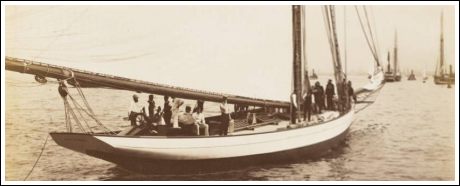
The rival yachts under mainsail, forestaysail, club-topsail and jib, moved leisurely ever toward the Staten Island shore. On the Mayflower were General Paine, her owner; Edward Burgess, her designer; E. A. Willard, Dr. Bryant, Nathaniel Herreshoff and J. Frederick Tams. Her sailing-master, Captain Stone, was at the wheel, and "Joe" Ellsworth, looking unusually solemn, stood near him. On the Galatea were Lloyd Phenix, who represented the New-York Yacht Club; Frederick May, J. Beavor-Webb and Lieutenant and Mrs. Henn. The Lieutenant of the Royal Navy looked as good-natured and jolly as ever, and so perfectly happy at the prospect of a race that he did not seem to care how it resulted so long as it was a race.
The breeze that came creeping out of the south freshened, and as it became evident that the judges' boat would soon give the preparatory signal, the English and American yachts lay almost motionless with their sheets trimmed, flat aft, above the starting line. The Mayflower had her jib topsail run up in stops and the blue-shirted sailor was perched in her cross-trees like that "sweet little cherub that sits up aloft,' and who has become in the course of years and yacht races something of a "chestnut."
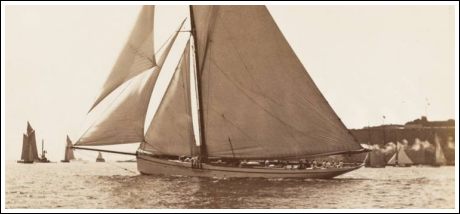
The crew of the Galatea, in suits of snick-and-span white, with their “Geordie caps'' of red and white on their heads, looked like sailors out of a picture-book. The most prominent thing on the deck of the Mayflower was a pair of flaming red suspenders which adorned General Paine. Those suspenders were gleaming and fiery. There were defiance and victory in them. All day long they gleamed over the waters like a rich ruby in a sapphire setting, but the Galatea never could get near enough for Lieutenant Henn to study their cut.
After some trouble the judges' boat succeeded in clearing an open space between itself and the buoy off Owl's Head and blew the preparatory signal. The yachts cautiously approached the line and the Mayflower broke out her jib-topsail. They were both close on to the line when the starting whistle was blown at 10:56 o'clock. Then took place one of the prettiest starts ever seen at a yacht race. The Mayflower was almost on the line with the Galatea on her weather quarter when the English yacht suddenly shot ahead and blanketed her rival.
![Mayflower [and] Galatea, the start. - John S. Johnston 01028S.jpg](/images/stories/1886/01028S.jpg)
They shot over the line together with only a second's difference in their time and with a speed that was wonderful to behold. In the light air the cutter swept ahead of her antagonist. The America's cup seemed dissolving into air. Surprise was on every face among the yachtsmen who looked on.
“The blamed thing can go." shouted one yachtsman in consternation. But the success of the English yacht was only momentary. The Mayflower soon regained what she had lost at the start. A strong flood tide was running at this time. The yachts crossed on the starboard tack and stood over to the Long Island shore, the Galatea being to windward. When well under the Long lsland shore the yachts came about almost at the same time. The Galatea was ahead, but the Mayflower soon began to eat out to windward. This windward position she constantly kept increasing. The Galatea seemed to go through the water faster than her rival, but she could not hold her own with the Mayflower in windward work. The superiority of the centre-board over the deep keel for helping a boat to get to windward was being demonstrated.
From the start to the finish the cruise was thirty eight miles long, and for this course the Mayflower allowed the Galatea thirty-eight seconds.
The time of the start was as follows:
Galatea.10:56:11
Mayflower. 10:56:12

The racing yachts held their way on the port tack toward the Staten Island shore, and when inside the line of merchant ships anchored there came on the starboard tack again. When they came on the starboard tack the windward position of the Mayflower gave her the lead and this lead she never again lost. The Mayflower, being ahead, got the fresh wind that drew up through the Narrows first, and still further increased her lead. Thus they passed out through the Narrows into the Lower Bay. A fair yachting breeze was blowing in the Bay which ruffled the waters, but there was no sea running, and besides the ceaseless churning of the tugs and steamers the lazy swell that relied in from the ocean was all that rocked the yachts.
Just below Fort Lafayette the Mayflower came about on the port tack. The Galatea still held her starboard tack. The Mayflower stood over to the West Bank and then came about on the starboard tack again. The Galatea had come on the port tack and was following the Mayflower over to the West Bank when the steamer St. Johns came down and ran across her bows, making a great swash which made the cutter rock and pitch.
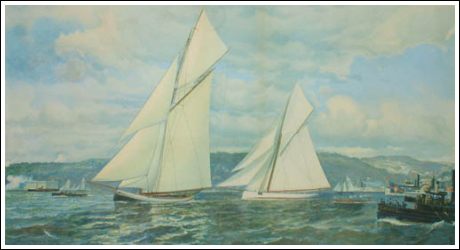
The Mayflower stood over toward Coney Island Point and then at 11:35 came about on the port tack again. One minute later the Galatea came on the starboard tack. The Mayflower made a short leg and then came on the starboard tack once more. When the yachts got so far to the eastward that they could see the waves creeping up the white sands on the western shore of Coney Island, they came about on the port tack, the Galatea setting the example.
 |
|
As they now went reaching to westward It seemed as if the Galatea had gained a little on the American boat. But the gain was not enough to give any fear that the Boston yacht would drop behind.
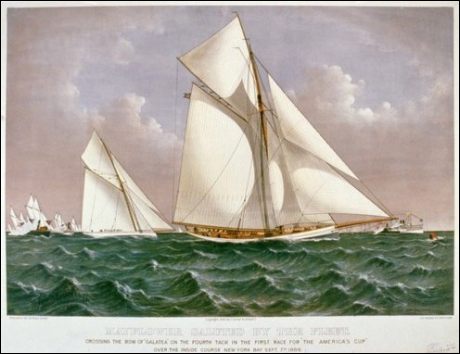
At 11:56 the cutter made a short leg on the starboard tack, but soon after came back again on the port tack. The Mayflower came on the starboard tack at 12:00, but came about again five minutes later. The Galatea, after holding her tack for some time, came on the port tack and stood to the eastward. At 12:25:50 the Mayflower did the same. Thus they went tacking down to the Southwest Spit with steamers, tugs and yachts swarming around them. The Mayflower swept around Buoy No. 10 nearly five minutes in the lead. The time at this point was:
Mayflower.12:55:30
Galatea. 1:00:00

A little further on toward the Point of the Hook was Buoy No. 8½. The yachts rounded that mark at the following times:
Mayflower.1:01:51
Galatea. 1:07:07
Thus at Buoy No. 8½ the American boat led her antagonist five minutes and sixteen seconds. The wind had hauled more to the eastward now and was blowing from south-southeast, the yachts laid their course for the place where beyond the horizon they knew the red-hulled Sandy Hook Lightship was rocking on the waves for them to round. The wind began to fail as the yachts crossed the bar and those who had been through the harrowing experiences of last year, when day after day the wind refused to be a party to an international race between the Genesta and Puritan, felt their hearts go down with the wind. But their fears were needless, for after the lightship was rounded the breeze freshened again. It was a long reach out to the lightship, devoid of especial interest from a racing point of view, but a beautiful picture to look at. The Mayflower steadily increased her lead and, having stood far enough over to fetch the lightship, came about on the port tack and stood for the turning point of the race. She had taken in the small jib-topsail under which she had sailed so far, and had her balloon jib-topsail run up in stops ready to break out when she should round the lightship. By great exertions the judges' boat cleared a pathway for the sloop around the lightship among the inconsiderate tugs and steamers.

The Mayflower rounded the lightship nearly 10 minutes ahead of tbe Galatea amid a pandemonium of whistling of steamers and shouting of men. The time at which the yachts rounded the lightship was as follows:
Mayflower.2:35:02
Galatea.2:44:13
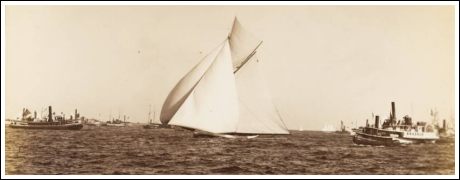 The Galatea took in her small jib topsail and set her balloon jib topsail and a large forestaysail after rounding. The crew of the cutter, usually so quick and handy, seemed to be demoralized at the certainty of defeat and were a long time in doing the work. When the Mayflower broke out her balloon jib topsail, which she did quickly and neatly, she took in her other head sails. The two yachts laid their course for the Point of the Hook and the Mayflower still further drew away from the Galatea as they went sliding toward the low sandy beaches that stretched along below the Highlands. The yachts rounded Buoy No. 10 on the run as follows: The Galatea took in her small jib topsail and set her balloon jib topsail and a large forestaysail after rounding. The crew of the cutter, usually so quick and handy, seemed to be demoralized at the certainty of defeat and were a long time in doing the work. When the Mayflower broke out her balloon jib topsail, which she did quickly and neatly, she took in her other head sails. The two yachts laid their course for the Point of the Hook and the Mayflower still further drew away from the Galatea as they went sliding toward the low sandy beaches that stretched along below the Highlands. The yachts rounded Buoy No. 10 on the run as follows:
Mayflower. 3:37:00
Galatea. 3:50:00
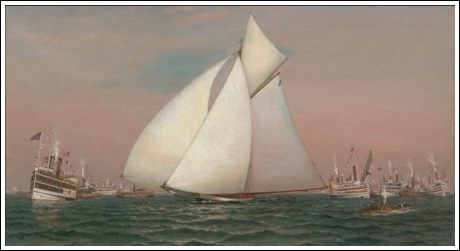
They now ran for the finish at Buoy No. 15, just outside the Narrows. The wind would scarcely admit from its direction of spinnakers being used until shortly before the finish, when the Galatea set her and carried it to the buoy. The Mayflower did not need to take the trouble. The tugs, steamers and yachts and the people on them seemed to go wild with excitement as the Mayflowers swept in a handsome winner, beating the Galatea 12 minutes, 40 seconds on actual time and 12 minutes 2 seconds on corrected time.
| |
Start. |
Finish. |
Actual
Times. |
Corrected
Times. |
| |
H. |
M. |
S. |
H. |
M. |
S. |
H. |
M. |
S. |
H. |
M. |
S. |
| Mayflower |
10 |
56 |
12 |
4 |
22 |
53 |
5 |
26 |
41 |
5 |
26 |
41 |
| Galatea |
10 |
56 |
11 |
4 |
35 |
32 |
5 |
39 |
21 |
5 |
38 |
43 |
When the Galatea came up past the judges' boat Lieutenant Henn, who seemed totake his defeat cheerfully, shouted:
“How much were we beaten?
- Twelve minutes” replied one of the regatta committee.
- I thought it was half an hour.” returned the lieutenant laughingly.

The times of the start, the finish, and every tack and turn were as follows: (from THE SUN published the same day)
| MAYFLOWER |
| |
|
H |
M |
S |
| |
Start |
10 |
56 |
12 |
| 1 |
Port |
11 |
00 |
30 |
| 2 |
Starboard |
11 |
12 |
30 |
| 3 |
Port |
11 |
21 |
00 |
| 4 |
Starboard |
11 |
27 |
00 |
| 5 |
Port |
11 |
34 |
00 |
| 6 |
Starboard |
11 |
41 |
00 |
| 7 |
Port |
11 |
49 |
00 |
| 8 |
Starboard |
12 |
03 |
30 |
| 9 |
Port |
12 |
09 |
00 |
| 10 |
Starboard |
12 |
19 |
30 |
| 11 |
Port |
12 |
24 |
30 |
| 12 |
Starboard |
12 |
38 |
30 |
| 13 |
Port |
12 |
42 |
10 |
| 14 |
Buoy 10 |
12 |
55 |
30 |
| 15 |
Buoy 8½ |
01 |
01 |
51 |
| 16 |
Port |
02 |
27 |
30 |
| 17 |
Lightship |
02 |
35 |
02 |
| 18 |
Buoy 8½ |
03 |
34 |
00 |
| 19 |
Buoy 10 |
03 |
37 |
55 |
| |
Finish |
04 |
22 |
53 |
|
 |
| GALATEA |
| |
|
H |
M |
S |
| |
Start |
10 |
56 |
11 |
| 1 |
Port |
11 |
00 |
30 |
| 2 |
Starboard |
11 |
13 |
30 |
| 3 |
Port |
11 |
27 |
30 |
| 4 |
Starboard |
11 |
34 |
45 |
| 5 |
Port |
11 |
47 |
00 |
| 6 |
Starboard |
11 |
55 |
00 |
| 7 |
Port |
11 |
59 |
00 |
| 8 |
Starboard |
12 |
12 |
30 |
| 9 |
Port |
12 |
20 |
00 |
| 10 |
Starboard |
12 |
35 |
00 |
| 11 |
Port |
12 |
40 |
00 |
| 12 |
Starboard |
12 |
53 |
30 |
| 13 |
Port |
12 |
54 |
00 |
| 14 |
Buoy 10 |
01 |
00 |
00 |
| 15 |
Buoy 8½ |
01 |
07 |
07 |
| 16 |
Port |
02 |
40 |
00 |
| 17 |
Lightship |
02 |
44 |
13 |
| 18 |
Buoy 8½ |
03 |
46 |
00 |
| 19 |
Buoy 10 |
03 |
50 |
00 |
| |
Finish |
04 |
35 |
32 |
|
|
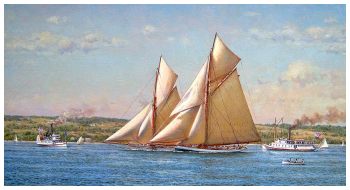 HURRAH for the MAYFLOWER !
HURRAH for the MAYFLOWER !